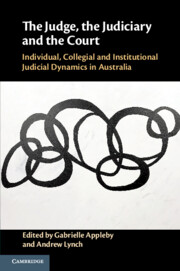 The Judge, the Judiciary and the Court
The Judge, the Judiciary and the Court Under Relational and Institutional Pressure
from Part I - The Judge, the Judiciary and the Court
Published online by Cambridge University Press: 04 May 2021
This chapter examines the role and responsibilities of a chief justice. Using the judicial legitimacy values propounded by Richard Devlin and Adam Dodek, we argue that a ‘successful’ chief justice will promote and protect these values as they negotiate and manage the many relational dimensions of the role with other judges, with the executive, the Parliament, the profession, the academy, the media, and the wider public. Our study highlights interpretative disputes, including as to whether an individual chief justice has responded to genuine, as opposed to improperly perceived, threats to judicial values and about how a chief justice might best navigate between the values, particularly as new values, such as representativeness and efficiency, can appear in opposition to more traditional values. Such questions are symptomatic of ongoing disagreement about the fragility of judicial values, particularly independence, as well as the subjective nature of any attempt to evaluate judicial performance. We argue that there is a need for a more developed normative framework to better understand – and critique – the individual choices and actions of chief justices.
To save this book to your Kindle, first ensure [email protected] is added to your Approved Personal Document E-mail List under your Personal Document Settings on the Manage Your Content and Devices page of your Amazon account. Then enter the ‘name’ part of your Kindle email address below. Find out more about saving to your Kindle.
Note you can select to save to either the @free.kindle.com or @kindle.com variations. ‘@free.kindle.com’ emails are free but can only be saved to your device when it is connected to wi-fi. ‘@kindle.com’ emails can be delivered even when you are not connected to wi-fi, but note that service fees apply.
Find out more about the Kindle Personal Document Service.
To save content items to your account, please confirm that you agree to abide by our usage policies. If this is the first time you use this feature, you will be asked to authorise Cambridge Core to connect with your account. Find out more about saving content to Dropbox.
To save content items to your account, please confirm that you agree to abide by our usage policies. If this is the first time you use this feature, you will be asked to authorise Cambridge Core to connect with your account. Find out more about saving content to Google Drive.